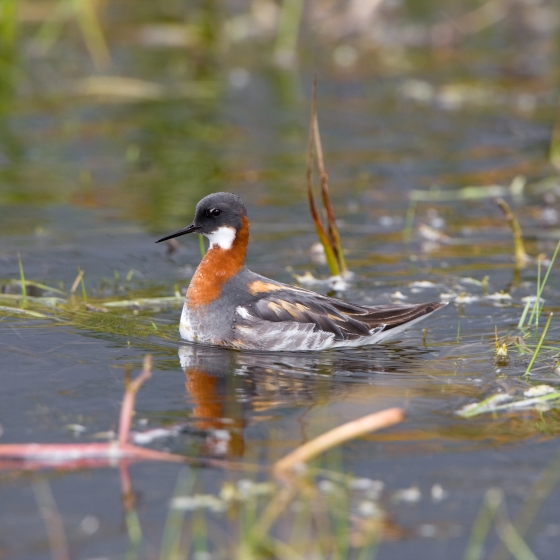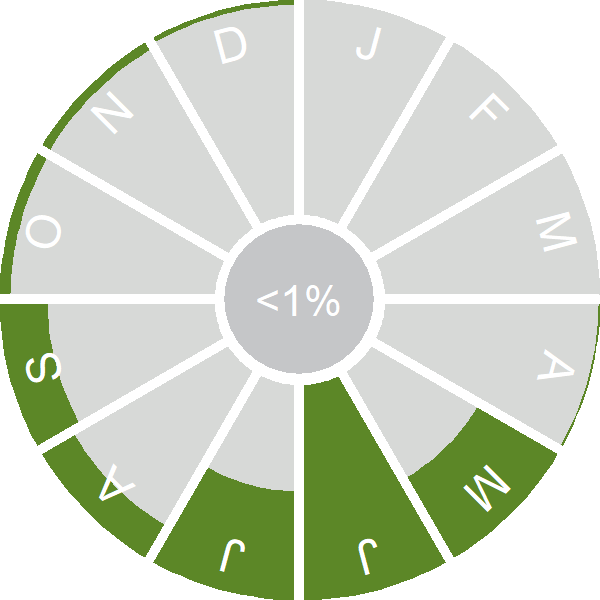Red-necked Phalarope

Introduction
Red-necked Phalarope is a beautiful tiny wader and one that, as a breeding species, has a preference for waterbodies with plenty of emergent vegetation.
The species is a migrant, returning to Scotland in spring from wintering quarters at sea. Remarkably, tracking studies have revealed that Scottish individuals can winter as far away as the eastern Pacific. With a breeding population of just a couple of dozen pairs, this is not a species easily encountered by the casual observer.
Phalaropes have reversed gender responsibilities with the duller-plumaged male looking after the nest and chicks. Females have a striking scarlet neck patch, set-off by a slate grey head and bright white throat. These birds have an unusual feeding action, in which they spin around on shallow waters, creating a vortex that brings invertebrate prey to the surface.

Key Stats
Identification
Songs and Calls
Call:
Flight call:
Status and Trends
Conservation Status
Population Change
In the UK, Red-necked Phalarope is restricted to Scotland and the population fluctuated between 1968–72 and 2008–11 from around 15 to 30 breeding pairs (Balmer et al. 2013). However, there has been a strong increase in the population over the 25 years to 2019, with a five-year mean of 78 breeding pairs over the period 2015–2019.
Distribution
Red-necked Phalaropes are very rare breeders in Scotland and Ireland. The main UK stronghold is Shetland; birds were also present on the Outer Hebrides, Inner Hebrides and in northeast Scotland.
Occupied 10-km squares in UK
or view it on Bird Atlas Mapstore.
or view it on Bird Atlas Mapstore.
European Distribution Map
Distribution Change
Red-necked Phalarope range and numbers have fluctuated over the course of the breeding atlases.
Change in occupied 10-km squares in the UK
or view it on Bird Atlas Mapstore.
or view it on Bird Atlas Mapstore.
Seasonality
Red-necked Phalaropes are late-spring migrants and a rare breeding species, with autumn passage of juveniles from September onwards.
Weekly pattern of occurrence
The graph shows when the species is present in the UK, with taller bars indicating a higher likelihood of encountering the species in appropriate regions and habitats.

Movement
Britain & Ireland movement
Foreign locations of birds ringed or recovered in Britain & Ireland
Dots show the foreign destinations of birds ringed in Britain & Ireland, and the origins of birds ringed overseas that were subsequently recaptured, resighted or found dead in Britain & Ireland. Dot colours indicate the time of year that the species was present at the location.
- Winter (Nov-Feb)
- Spring (Mar-Apr)
- Summer (May-Jul)
- Autumn (Aug-Oct)

European movements
EuroBirdPortal uses birdwatcher's records, such as those logged in BirdTrack to map the flows of birds as they arrive and depart Europe. See maps for this species here.
The Eurasian-African Migration Atlas shows movements of individual birds ringed or recovered in Europe. See maps for this species here.
Biology
Productivity and Nesting
Nesting timing
Egg measurements
Clutch Size
Survival and Longevity
Survival is shown as the proportion of birds surviving from one year to the next and is derived from bird ringing data. It can also be used to estimate how long birds typically live.
View number ringed each year in the Online Ringing Report.
lifespan
Biometrics
Wing length and body weights are from live birds (source).
Ring Size
Classification, names and codes
Classification and Codes
- Order: Charadriiformes
- Family: Scolopacidae
- Scientific name: Phalaropus lobatus
- Authority: Linnaeus, 1758
- BTO 2-letter code: NK
- BTO 5-letter code: RENPH
- Euring code number: 5640
Alternate species names
- Catalan: escuraflascons becfí
- Czech: lyskonoh úzkozobý
- Danish: Odinshane
- Dutch: Grauwe Franjepoot
- Estonian: veetallaja
- Finnish: vesipääsky
- French: Phalarope à bec étroit
- Gaelic: Deargan-allt
- German: Odinshühnchen
- Hungarian: vékonycsoru víztaposó
- Icelandic: Óðinshani
- Irish: Falaróp Gobchaol
- Italian: Falaropo beccosottile
- Latvian: šaurknabja puslitis
- Lithuanian: apvaliasnapis plaukikas
- Norwegian: Svømmesnipe
- Polish: platkonóg szydlodzioby
- Portuguese: falaropo-de-bico-fino
- Slovak: lyskonoh úzkozobý
- Slovenian: ozkokljuni liskonožec
- Spanish: Falaropo picofino
- Swedish: smalnäbbad simsnäppa
- Welsh: Llydandroed Gyddfgoch
Research
Causes of Change and Solutions
Causes of change
Recent tracking studies have confirmed that the UK population is linked to the Icelandic population as both populations migrate to winter in the Pacific (Smith et al. 2014, 2018). The Icelandic population is also increasing but the drivers of these increases are not known.
Information about conservation actions
See Atlas account

